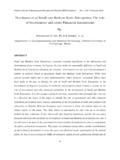Transcription of Technical Voices of the Hungry - Food and Agriculture ...
1 Technical Report Voices of the Hungry The Voices of the Hungry project has developed the Food insecurity Experience Scale, a new metric for household and individual food insecurity . Number 1/August 2016. It brings us a step closer to hearing the Voices of the people (Revised Version). who struggle every day to have access to safe and nutritious food. Photo cover: FAO/Giulio Napolitano Voices . of the . Hungry . Methods for estimating comparable prevalence rates of food insecurity experienced by adults throughout the world.
2 Carlo Cafiero*, Mark Nord, Sara Viviani, Mauro Eduardo Del Grossi, Terri Ballard, Anne Kepple, Meghan Miller, Chiamaka Nwosu FOOD AND Agriculture ORGANIZATION OF THE UNITED NATIONS. Rome, 2016. Recommended citation: FAO. 2016. Methods for estimating comparable rates of food insecurity experienced by adults throughout the world. Rome, FAO. Note to the reader: In this version of the report, statistics for Mexico have been revised due to a processing error for Mexico national survey data in the earlier release.
3 Minor typos have also been corrected, but the only changes in statistical results are those for Mexico prevalence rates. The designations employed and the presentation of material in this information product do not imply the expression of any opinion whatsoever on the part of the Food and Agriculture Organization of the United Nations (FAO) concerning the legal or development status of any country, territory, city or area or of its authorities, or concerning the delimitation of its frontiers or boundaries.
4 The mention of specific companies or products of manufacturers, whether or not these have been patented, does not imply that these have been endorsed or recommended by FAO in preference to others of a similar nature that are not mentioned. The views expressed in this information product are those of the author(s) and do not necessarily reflect the views or policies of FAO. ISBN 978-92-5-108835-7. FAO, 2016. FAO encourages the use, reproduction and dissemination of material in this information product. Except where otherwise indicated, material may be copied, downloaded and printed for private study, research and teaching purposes, or for use in non-commercial products or services, provided that appropriate acknowl- edgement of FAO as the source and copyright holder is given and that FAO's endorsement of users' views, products or services is not implied in any way.
5 All requests for translation and adaptation rights and for resale and other commercial use rights should be made via or addressed to FAO information products are available on the FAO website ( ) and can be purchased through ii Contents Tables .. iv Figures .. iv Acknowledgments .. v A formidable challenge .. 1. 1. The concept: food insecurity seen through the lens of people's 3. 2. The Food insecurity Experience Scale Survey Module (FIES-SM) .. 7. 3. Data collection through the Gallup World Poll .. 9. 4.
6 Analyzing FIES data with the Rasch model .. 11. 5. Developing the FIES global standard scale .. 15. 6. Computing comparable prevalence rates .. 17. 7. Results to date: data quality .. 21. 8. Results to date: prevalence rates .. 27. Filling a gap in our ability to measure food insecurity .. 31. References .. 34. Appendix .. 36. Annex I - Prevalence Rates Based on National Government Survey Data .. 41. Annex II - Number of food insecure adults and number of individuals in the total population affected by food insecurity .
7 48. iii Tables Table 2-1 Questions in the Food insecurity Experience Scale Survey Module for Individuals (FIES SM-I) as fielded in the 2014 GWP .. 7. Table 7-1 Summary of missing responses to food security questions in the first 146. datasets for which 2014 GWP data were available .. 21. Table 7-2 Summary of item infit statistics for 136 datasets in the 2014 GWP .. 22. Table 7-3 Summary of item outfit statistics for 136 datasets in the 2014 GWP .. 22. Table 7-4 Mean residual correlations between items (136 datasets from the 2014.)
8 GWP) .. 23. Table 8-1 Descriptive statistics of the food insecurity prevalence rates (143. datasets in 2014) .. 27. Table 8-2 Distribution of countries, areas or territories for different classes of FImod+sev and FIsev .. 28. Table 8-3 Spearman's rank correlation between food insecurity indicators and selected indicators of development at country level.. 28. Table 8-4 Regression analysis of food security and poverty indicators on child mortality rates .. 29. Table A-1 Prevalence rates of food insecurity in 146 countries, areas or territories in 2014.
9 36. Table A-2 Selected Indicators of Development used in the correlation analysis .. 40. Table A-3 Prevalence rates calculated from national government survey data and from FAO- GWP data.. 47. Figures Figure 1-1 Food insecurity experiences and associated severity levels .. 4. Figure 6-1 Estimated distributions of true severity among respondents with each raw score .. 18. Figure 7-1 Distributions of standardized values of item severity across countries.. 25. Figure 7-2 The FIES global standard .. 25. iv Acknowledgments This publication is the revision of a preliminary version of the Technical report that was circulated for comments with a restricted list of reviewers in March 2015, in preparation for a Technical expert meeting that was hosted at FAO headquarters on May 21-22 2015.
10 We wish to thank Ricardo Aparicio, Luis Beccaria, Jennifer Coates, Luis P rez Melgar, Rafael P rez Escamilla, Giovanni Battista Rossi, Ana Maria Segall-Corr a, Mark Wilson, Andrea Leigh McMillan (who coordinated the review conducted by Stats Canada), and Steve Crutchfield (who coordinated the one conducted at USDA ERS) for the input provided. Thanks are due to Pietro Gennari, Josef Schmidhuber, Piero Conforti and Vikas Rawal, in addition to all participants in the expert meeting in May 2015, for useful comments and suggestions.













